Hen of the Woods – Identification, Edibility, Distribution, Medicinal Uses, Ecology, Sustainable Harvesting
Grifola frondosa
aka Maitake (Japan – which translates to “Dancing Mushroom“), Signorina (Italy – which translates to “Unmarried Woman”), also occasionally called ram’s head or sheep’s head mushroom
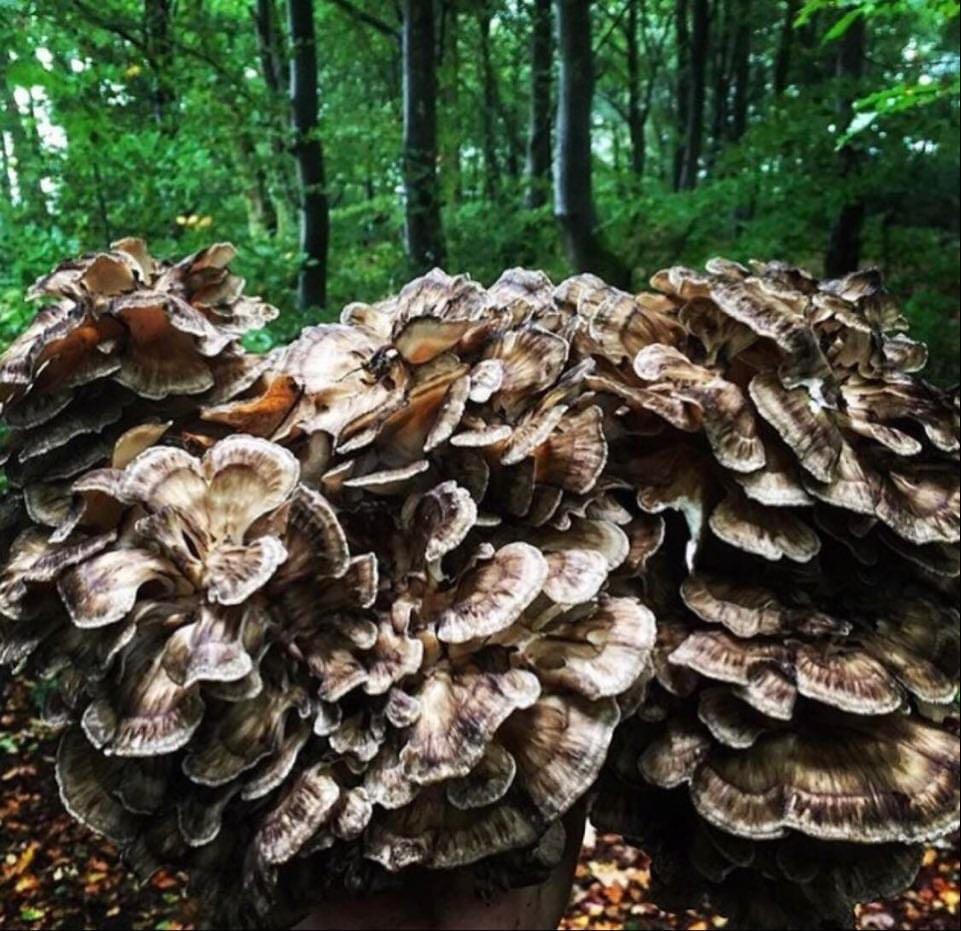
Hen of the Woods, Grifola frondosa
I try to resist choosing a “favourite” wild mushroom – they have such distinct personalities and idiosyncrasies of growth habit, flavour, abundance and usage that ranking them doesn’t seem meaningful, even if it were possible. But if I was forced, with a mushroom knife to my throat, to pick a favourite, I think it would have to be hen of the woods. They have a wonderful combination of physical beauty, size, intriguing ecological roles, enigmatic qualities, delicious flavour, versatility in the kitchen, meaty texture, (reasonable) resistance to insect infestation, and medicinal benefits to make them utterly thrilling to find.
Perhaps of all these, it is their enigmatic quality that raises them above other fungal treasures. While they are by no means rare, their large size and not entirely predictable appearance, makes them feel like the big game of wild mushroom hunting. Certainly one of the greatest pleasures for fungi foragers is stumbling on one of these unexpectedly, and it is this that has given it its Japanese name of “dancing mushroom”. According to a Japanese legend, a group of Buddhist nuns and woodcutters met on a mountain trail, where they discovered a fruiting hen of the woods. They were so thrilled at their discovery that they danced to celebrate! Once you get to know them, you too will dance for joy when you find one!
Identification – 4/5
A large and distinctive fungus, comprising a mass of interlocking flat lobed fronds growing from a dense core, at the base of oak trees. Fully grown specimens can be up to 70cm round and several kilos in weight, occasionally much larger, and multiple growths can emerge from the same host tree. The colour of the top of fronds varies from tan to olive, grey or cream in undulating concentric zones. Some hen of the woods have a brownish colour scheme, others come in greyer hues. The pore layer on the underside of the fronds is always cream coloured. Flesh is pale cream throughout.
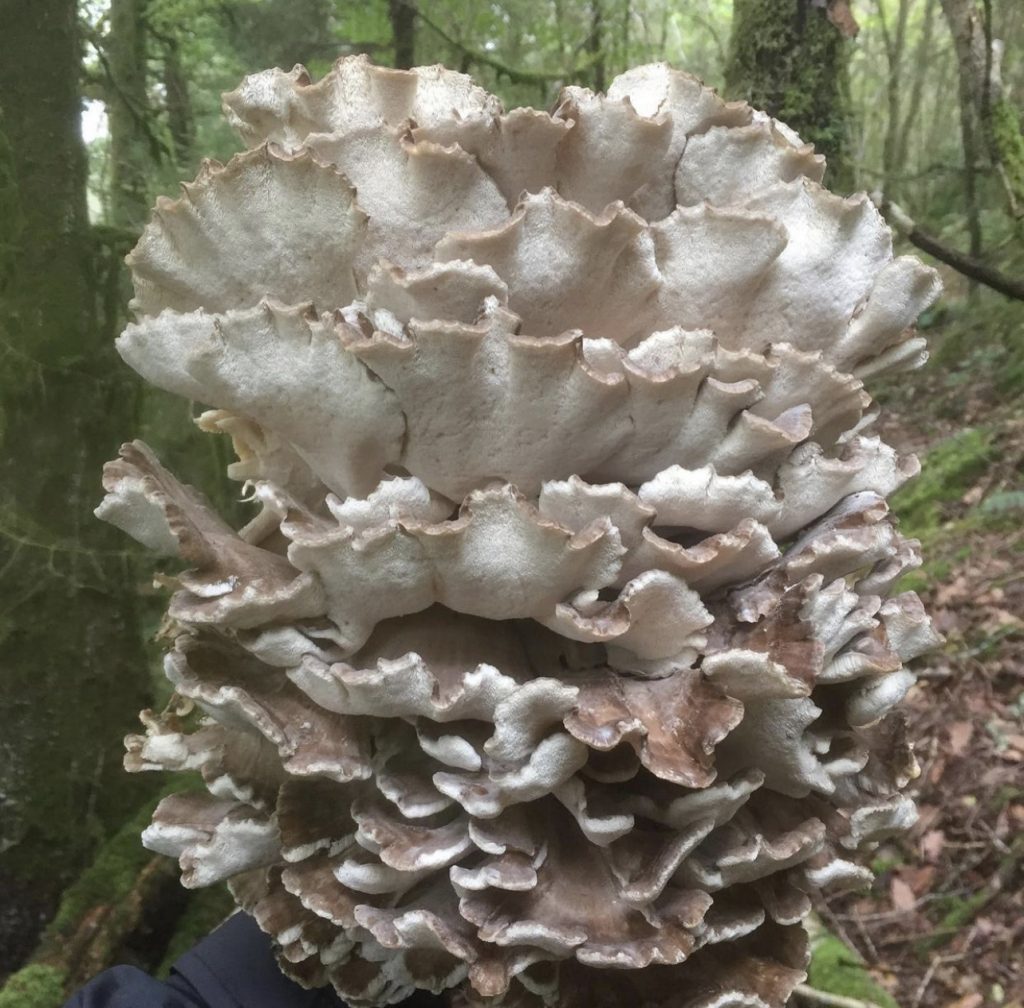
Cream/white pore layer on underside of fronds
Rare pale forms of hen of the woods have been recorded, but normal coloured specimens often fade with age, leaving the whole thing a dingy pale brown to cream colour. The smell is rich – slightly nutty, spicy, musky, earthy, becoming more resonant as the mushroom grows and ages.
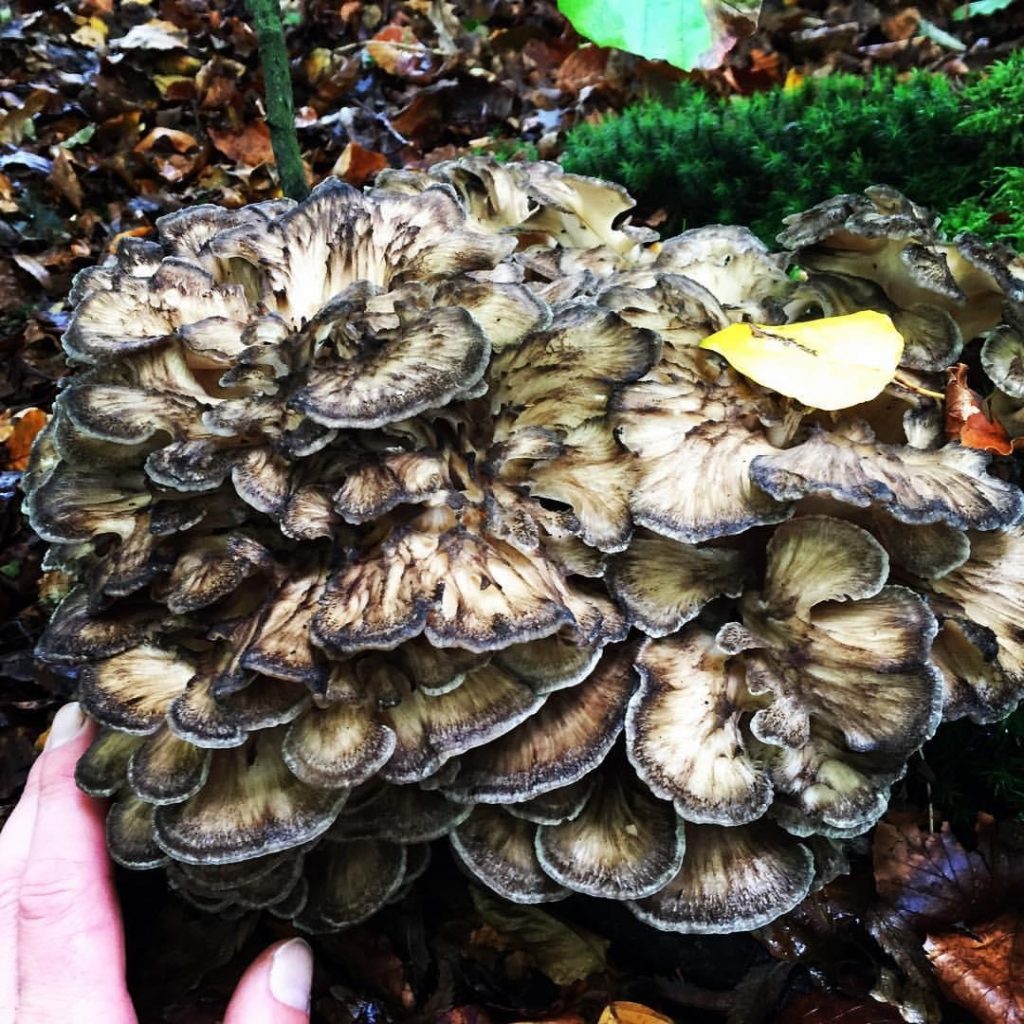
Hen of the woods, grifola frondosa, older specimen starting to lose colour
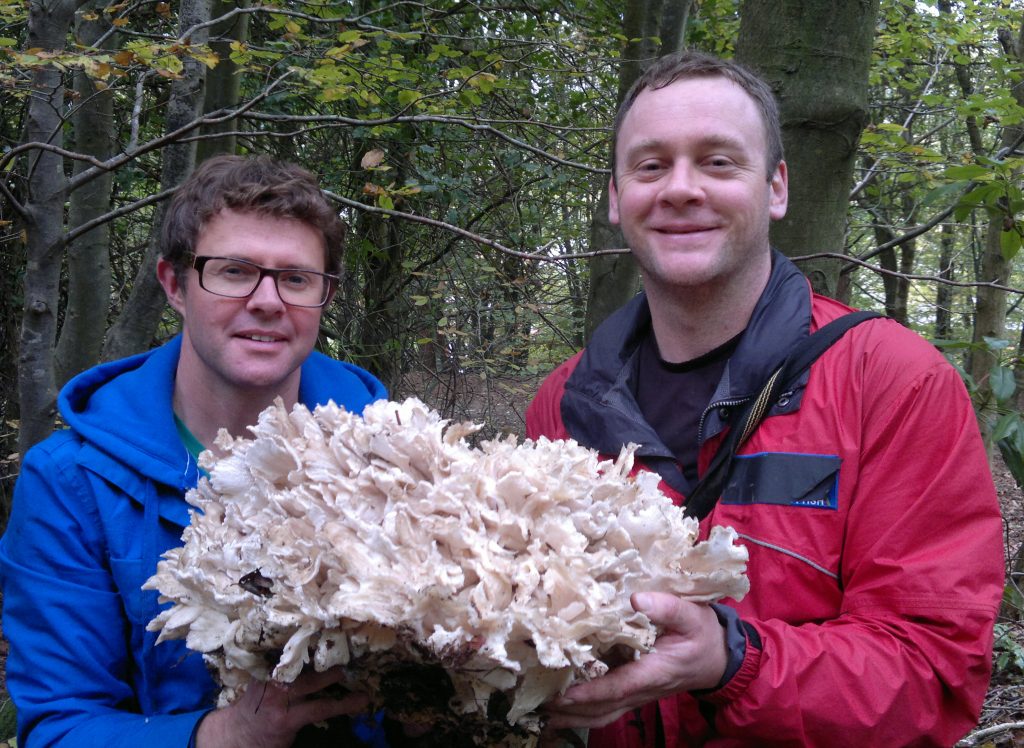
A very large, pale hen of the woods. It is pale because it was old and faded, but still in great condition. I’d been asked to find a mushroom for a children’s TV programme that didn’t look remotely like anything that could be poisonous, even to children. This monster was a godsend! The man on the left is TV presenter Stefan Gates
Similar Species
Hen of the Woods is very distinctive, with just a few somewhat similar species, most of which are edible:
- Giant polypore (aka blackening polypore, Meripilus giganteus). Another root-rotting parasite-saprotroph, usually appearing at the base, or remains, of beech trees, though can also occasionally appear with oak and other hardwoods. Distinguished by its even bigger size (2 foot high “stacks” are not unusual), broader lobes, tan – orange colouration, with less obvious colour banding than hen of the woods, and tendency to turn black with age or when damaged. Edible, but not so esteemed as hen of the woods as it quickly becomes tough, bitter and hard to digest as it grows.
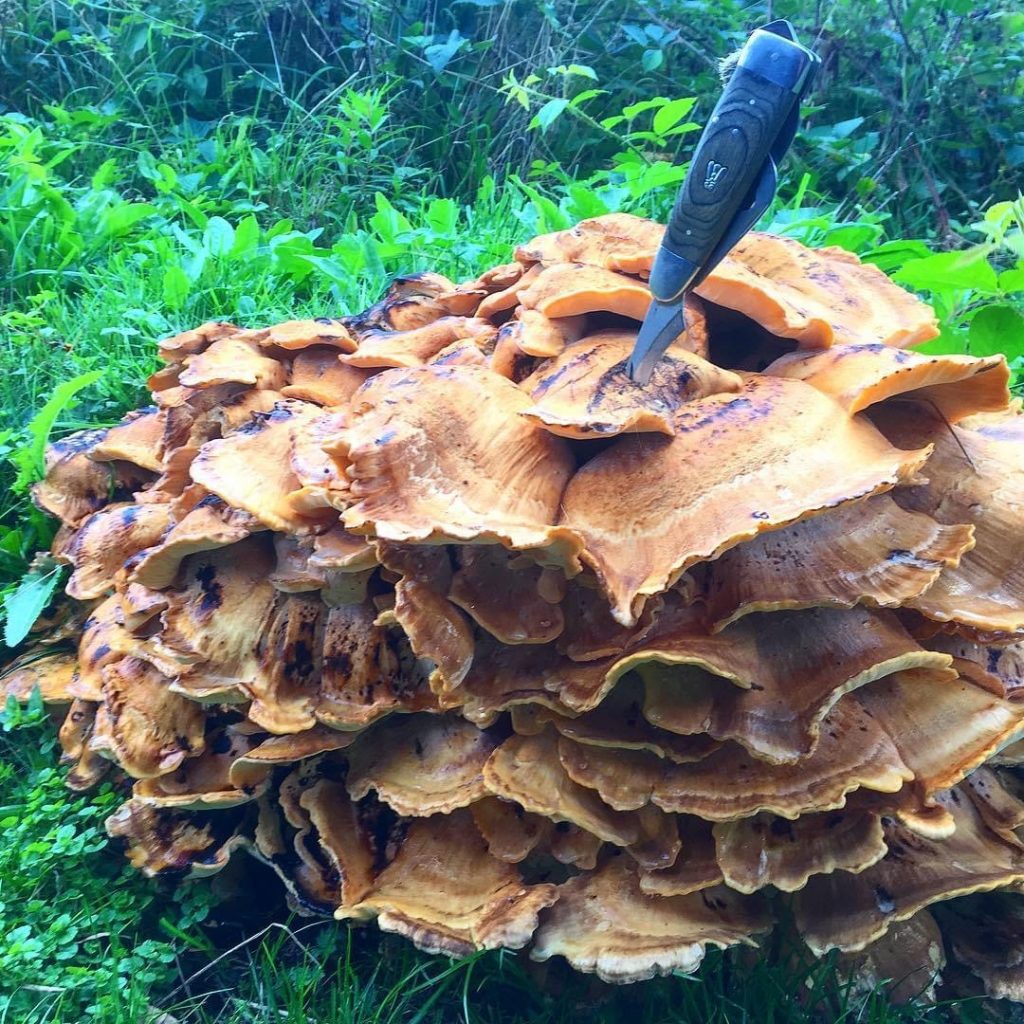
Giant polypore with its typically broad lobes and tan colouration
- Chicken of the Woods (Laetiporus sulphureus) – see here for info and photos. Despite their similar names, and shared liking for oak trees, chicken of the woods is really quite different from hen of the woods! It almost always grows higher up trees, rather than at the base, has broader lobes, and is easily distinguished by its bright orange and yellow colours -but as it ages (to the point of being inedible), they can become drab and more reminiscent of hen of the woods
- Cauliflower fungus (Sparassiss crispa) – see here for info and photos – much more finely lobed, and without the zonal markings
- Dyer’s mazegill (Phaeolus schweinitzii) is another large, multi-tiered fungus that grows at the foot of old trees and stumps, but only with conifers. It has a wooly texture and is bright yellow to orange when young, maturing to black/brown with a coloured outer rim, before fading to fully black. As its name suggests, young specimens can be used for dying fabrics yellow and rusty hues. It is not edible, and may well give you an unpleasant tummy upset.

Dyers mazegill, Phaeolus schweinitzii. Grows only with conifers, and not especially similar to hen of the woods – but very beautiful!
Edibility – 5/5
Hen of the woods is one of our finest edible wild mushrooms, with a meaty texture and a resonant spicy/nutty flavour. It contains L-glutamate, a natural flavor-enhancer, rammed with umami, that stimulates flavour receptors and makes the mushroom, and anything it is served with, even more delicious! (For a discussion of umami in fungi and seaweeds, see here.)
Even before eating, it is a sensual pleasure to break down a hen of the woods, peeling fronds apart and brushing out bits of forest debris as you go. Only older soggy specimens tend to be seriously troubled by insect larvae within their flesh, though you may find quite a few beasties that hide among their fronds, like fish hide among coral. Once cleaned hen of the woods can be cooked and preserved in a number of ways. Although it can be eaten raw, I think it best eaten cooked, and as with all wild mushrooms, its worth trying just a small bit, well cooked if its your first time. Its far from being one of those more gastically troublesome mushrooms, so an adverse reaction is unlikely.
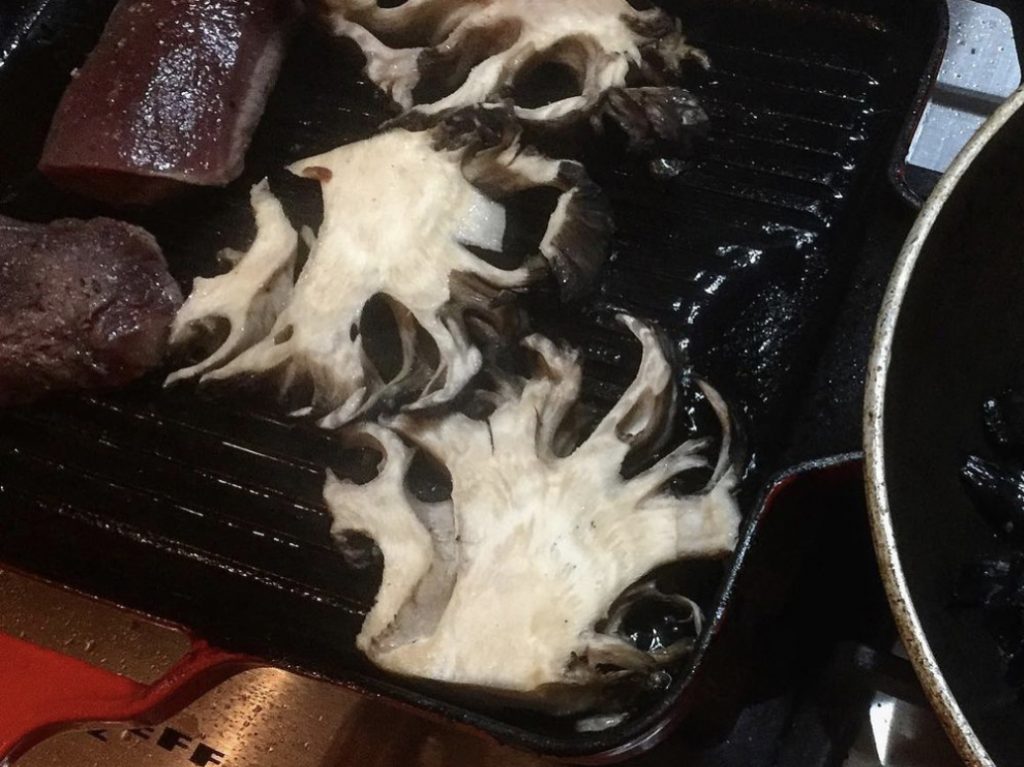
Hen of the woods steaks on the griddle
The whole thing can be eaten, including the dense core from which the fronds grow, provided it feels moist and tender. This can be sliced into “steaks” and seared and butter-basted as you might cook a big piece of fish. Finish it with savoury dried seaweed or mushroom powders like truffle weed, tubular weed, pepper dulse, or peppery bolete, and a scatter of finely chopped hazelnuts works well too.
View this post on Instagram
Fronds too are meaty and substantial, and work well in stir-fries, or as a hefty breakfast mushroom. They will also stand up to stewing for longer periods, marinading and cooking sous vide.
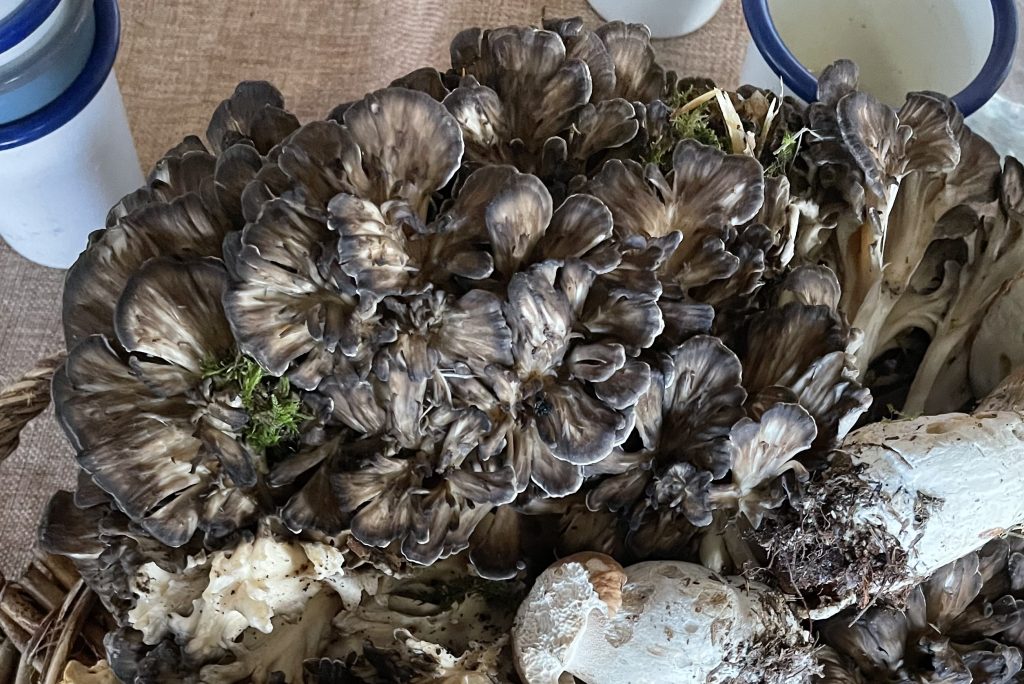
Middle aged hen of the woods, with fronds still quite densely packed tend to have the best flavour and texture, though they remain excellent eating at most stages of growth
Even if you’ve only found one, you are likely to have lots of hen to play with, so its a great bulker for wild mushroom paté or soup – though the word bulker does something of a disservice to its excellent flavour!
It also dries well, and can be pickled too. My favourite way to pickle it is with ginger, garlic and soy sauce.
How to pickle hen of the woods and other mushrooms
Once fully dehydrated they can be ground to a fine powder which adds deep fungal umami to stocks, soups and sauces. My friend Craig even smokes his hen of the woods before drying and powdering, for the ultimate fungal umami powder!
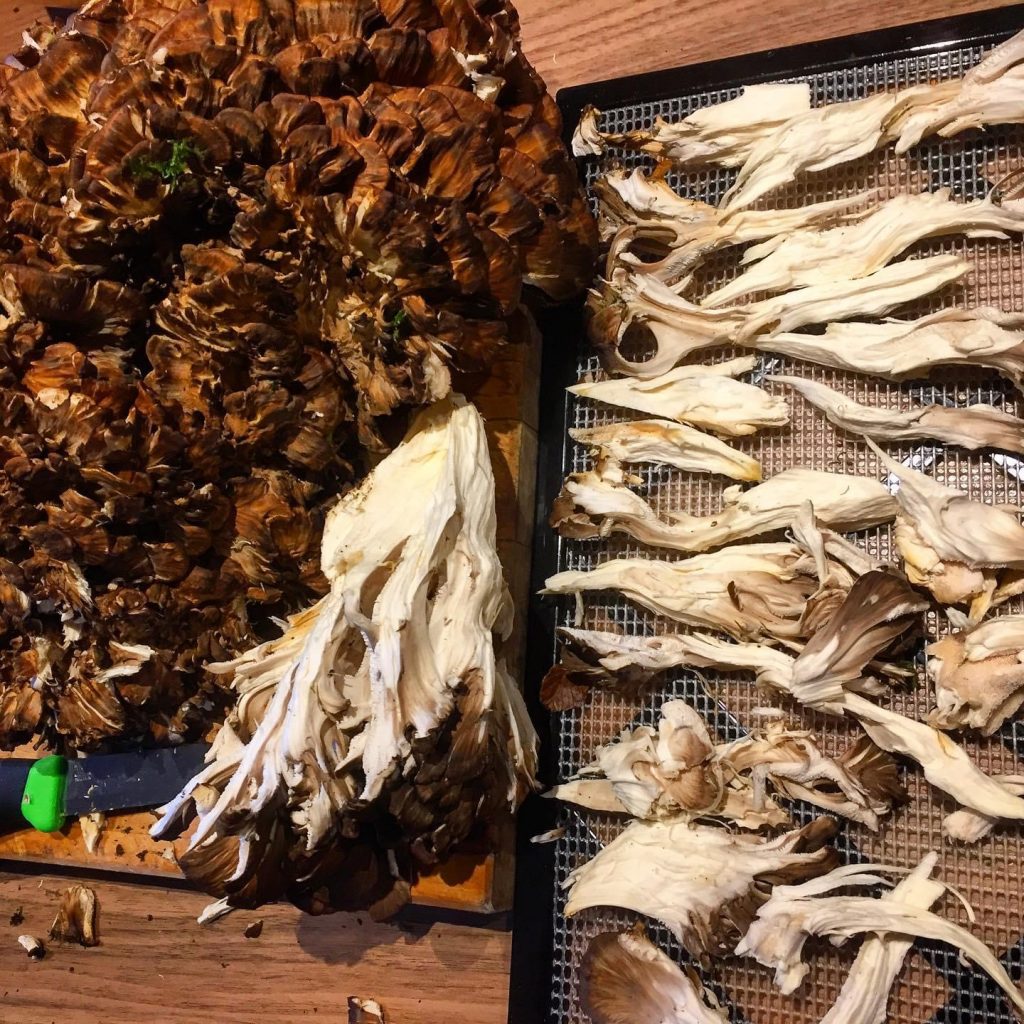
Pull apart the fronds of hen of the woods before dehydrating
Hen of the woods has – to an extent – been tamed, and is now widely cultivated for its gastronomic and medicinal properties. Being a wood-rotting fungus, it is grown from from inoculated sawdust or stumps. Mushroom cultivators call its colourless nascent form “brains” and consider them extra succulent and tasty. Although i’m generally a bit sniffy about cultivated “exotic” mushrooms versus genuinely wild mushrooms, in a world that is creating all sorts of diabolical Frankenstein plant based “foods”, I’m all for cultivating this delicious, fast-growing, protein-packed nutritious mushroom.
Nutritional benefits and Medicinal Uses of Hen of the woods
Hen of the woods has a long history of use in traditional eastern medicine, a history that current research is only beginning to catch up with. Modern biochemical data shows an array of active constituents and compounds that assist the human body in the maintenance of health and in healing processes.
In terms of nutrition, organically grown hen of the woods contain, as percentages of dry weight:
- 377 calories per 100 grams
- 25% protein
- 3-4% fats (1% polyunsaturated fat; 2% total unsaturated fat; 0.3% saturated fat)
- ≈60% carbohydrates (41% of which are complex carbohydrates)
- ≈28%fiber
- Zero cholesterol
- B vitamins (mg/100 g): niacin (64.8mg); riboflavin (2.6 mg); and pantheonic acid (4.4 mg)
- High concentration of potassium: 2,300 mg/100 g (or 2.3 percent of dry mass!)
[Source: Paul Stamets]
Several studies show hen of the woods to modulate glucose levels, which can be especially important for limiting the development of Type 2 diabetes. (Kubo et al., 1994; Konno et al., 2001; Preuss et al., 2007; Lo et al., 2008).
It has also been widely researched for its effects on the immune system and various cancers, and it is thought that its rich array of polysaccharides can be effective in boosting immune systems, increasing its potential to kill and consume lung and breast cancer cells (Deng et al. 2009; Lin, 2011). Other reports have cast some doubt on the methodology of these reports, so its fair to say that the scientific jury is still out on this area.
What seems clear to my non-scientific eye, is that eating hen of the woods has no known down-sides, and lots of potential benefits.
For me, its enough to include hen of the woods in my meals, as delicious food that helps me to stay healthy as part of a biodiverse diet, rather than as “medicine” per se. But if you do wish to unlock its full spectrum of medicinal potential, herbalists recommend dual extraction as tincture (infusing into alcohol) and decoction (think like strong tea). You can read about these processes here.
I am satisfied to get some of those properties by, for example, adding it to broths, stock pots or mushroom vermouths or schnapps.
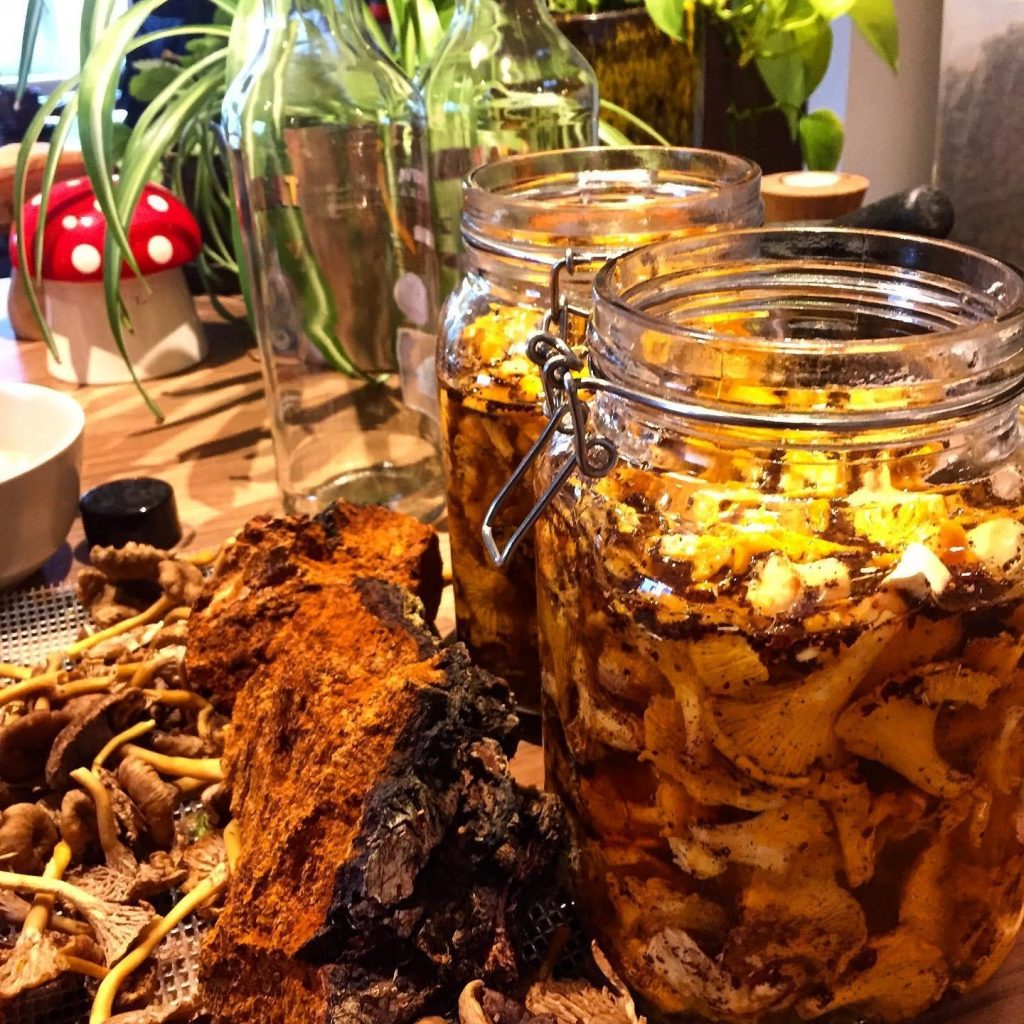
Preparing Wild mushroom schnapps, which I later sweeten with birch sap syrup. This is a fun, tasty way of accessing some of the deeper benefits of tasty, medicinal mushrooms
Distribution – 3/5
Hen of the Woods is best described as occasional: while it is certainly not an uncommon find in well established oak woods between September and November in the UK, you aren’t going to be finding dozens unless you get extremely lucky or have been collecting known host locations for several years.
I tend to find anywhere from one to a dozen each season by visiting about 10 known host trees from previous seasons, plus random exploration of new areas. We are lucky to have a lot of well established oak woodland in Galloway. While it will reappear regularly at the foot of host trees, like cauliflower fungus, it can often miss a year or more. It also seems to have “mast years” – where it proliferates right across the UK, forming more fruit bodies on existing hosts, and at the foot of previously unproductive nearby oaks, than in regular seasons. Social media has proven to be a good way to roughly assess prolific years for certain fungi across wide geographic areas and 2020 appears to have been epic for hen of the woods right across the UK. In Galloway that year, where I might usually have expected to find 4 or 5 in a season, I found 25, and foraging friends across England reported a similar boom.
For such a large and flamboyant mushroom, hen of the woods can be surprisingly easy to overlook, blending with the colours of oak bark and autumn leaves. I once carefully inspected a tree that had had produced hen of the woods on previous years ahead of a guided fungi walk I was leading. I was a little disappointed not to find one as its a real pleasure to introduce these guys to people, a memorable high point on forays. However, the next day, on the walk itself, there was a large, fully formed hen of the woods right at the foot foot of tree that I thought i’d carefully checked! They do grow fast, but not that fast!
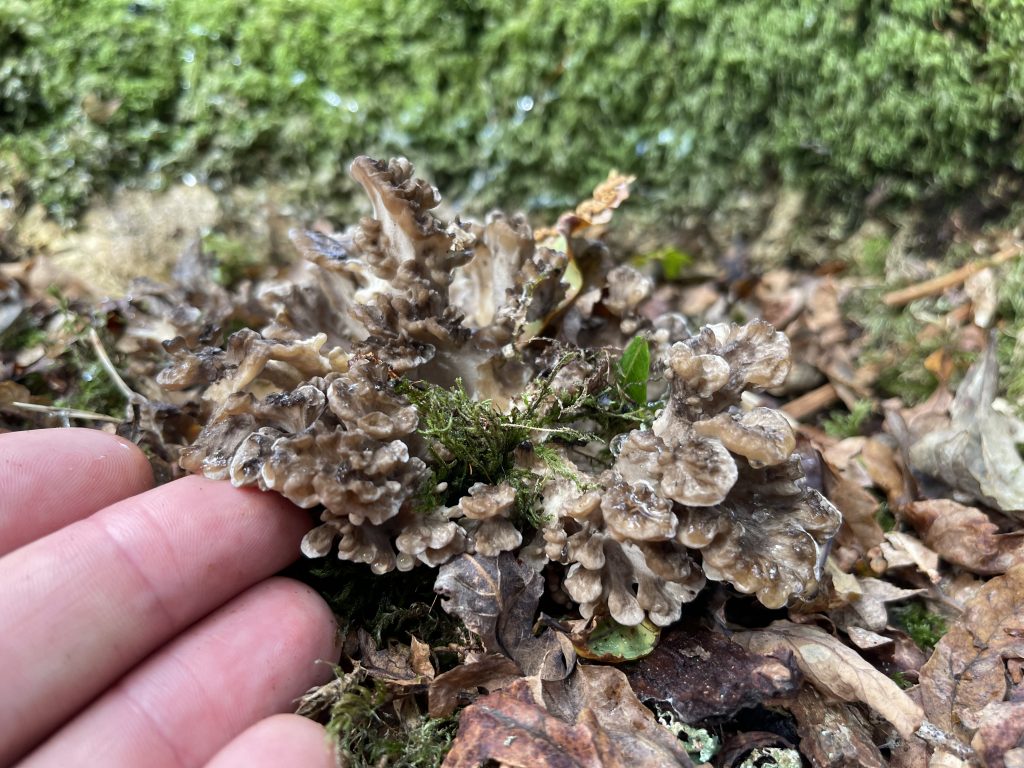
Young hen of the woods can be quite easy to miss – or worse still, stand on!
Habitat
In the UK hen of the woods grows almost exclusively at the base of oak trees, though very occasionally they have been found at the base of other deciduous trees. The British Basidiomycota checklist reports it to have also been found growing from chestnut, hazel, beech, ash, holly, sorbus, pear, rhododendron and even a cedar tree in Kew Gardens! I have found one growing at the base of a beech tree, but I suspect it was actually feeding on the roots of a nearby oak, and wonder how many finds with other hosts have had oak close by? My advice is to remain open to, but not be too distracted by, these unusual occurrences, and focus all your attention on oak if you want to find a hen!
The older the oak trees you inspect, the greater your chance of finding one, and you are highly unlikely to find them on recently planted oak trees, which still have youthful and vigorous natural defences against parasitic fungi.
They particularly like to nestle – like a broody hen – in the gaps between buttress-like roots on 200+ year old oaks.
They will continue to grow from stumps and buried root systems for some years after the host tree has fallen or been felled and removed – even occasionally grassed over, so it may look like there is no tree present – this may also account for some reports of it appearing to grow with other unlikely sounding hosts.
Occasionally I find hen of the woods that are growing further up (1 to 2 metres at most) old oak trees, as with the one pictured below.
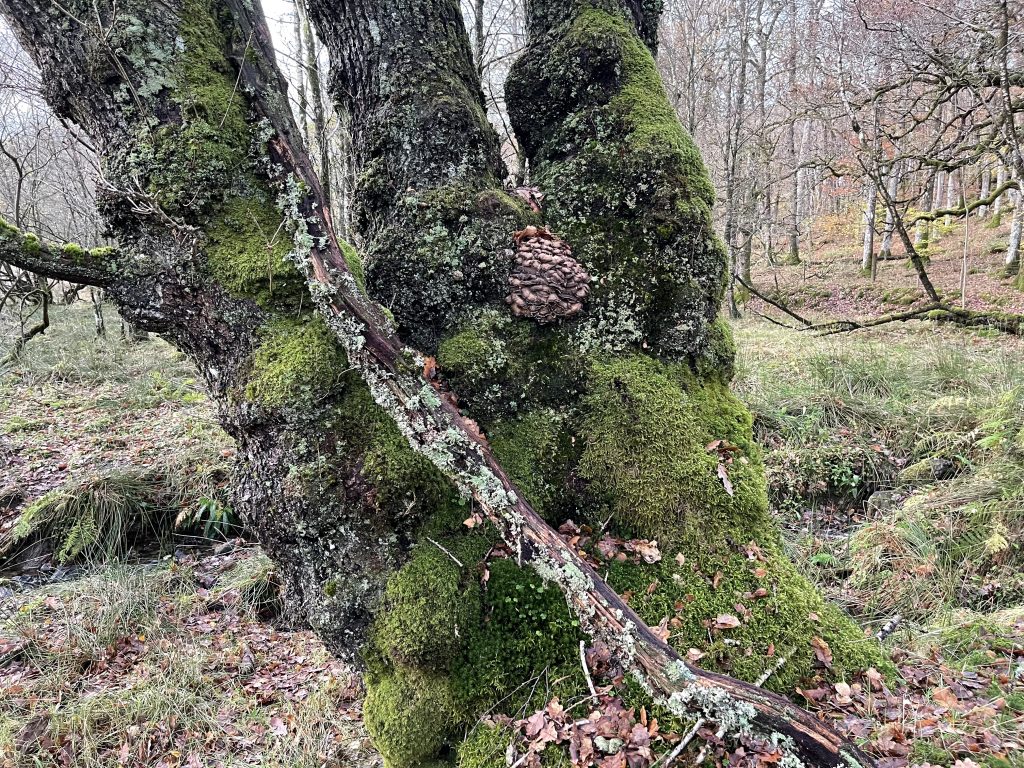
Hen of the woods growing higher up an oak tree. This is fairly unusual.
Ecological Role
Hen of the Woods is weakly parasitic then saprotrophic, feeding on the roots of ageing, fallen or felled trees.
In its parasitic phase it causes a white rot in living tree roots, ultimately weakening them, but this is by no means a quick death sentence. I visit oak trees that have hosted hen of the woods for over 30 years, and are still in good health. Though I’ve found no scientific corroboration of this, from my observations it seems likely that hen of the woods actively protects its host from rival parasitic fungi – like a lion guarding its prey from wild dogs.
For example, a wood near me is full of aggressively parasitic honey fungus, but the oldest oak in the woods is attended by a hen of the woods and shows no signs of honey fungus. Now it may be that as the tree is so old that its defences against the hen of the woods have been compromised, but there are hundreds of younger oaks nearby that have succumbed honey fungus, so why has the oak been spared? Its my belief that it has reached this great age because the hen of the woods is actively defending it.
Hen of the woods provides shelter for invertebrates among its fronds, and later, as it becomes soggy, fly and gnat larvae will make it home, nursery and larder.
Season: September – December
Speed of growth can vary, but is generally pretty quick, with tennis ball sized young specimens becoming fully grown football – to – beachball sized in a one to three weeks. Fully grown specimens can persist for several weeks and are reasonably resistant to insect larvae up to the point they become soggy.
Sustainable and Considerate Harvesting
These mushrooms often grow so large it is possible to cut a month’s supply from a single specimen, and still leave plenty behind! As large, slow-to-decompose mushrooms, portions of hen of the woods can be harvested, leaving the remainder to grow, spread spores and make other foragers dance.
Remember that you are harvesting the reproductive structure of a long-lived organism, and it may be grateful for having its spores broadcast over a wider area. Moving mature sections of hen of the woods homeward through the woods in a basket, with its pore bearing surfaces pointing downward, seems likely to help it to spread its spores more widely. Scattering trimmings at the foot of well established oak trees may help to introduce to new hosts, and the oak may well be glad of its new protector if honey fungus is around…
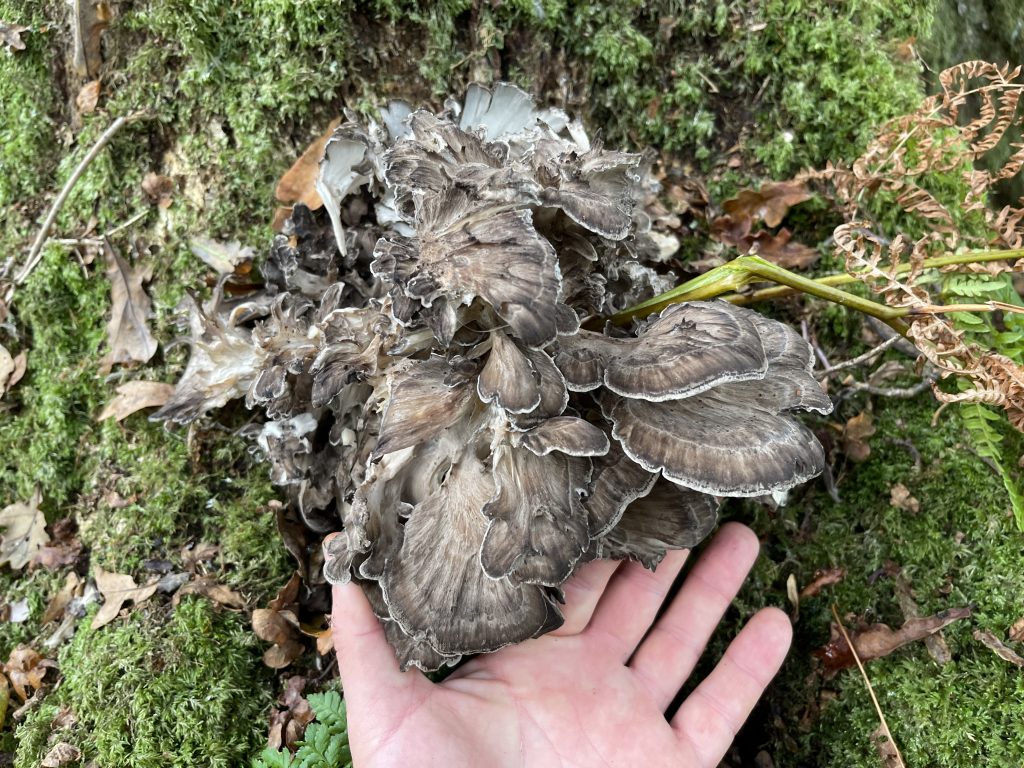
Hen of the woods does not always produce dense, fully formed “rosettes”. Often growth can be uneven or sparse.
Related Pages:
38 Comments
I found a huge clump here but it’s very bright orange is that edible?
I’ve often found it also dried looking brown or light brown!
If you read this whole post, you’ll see the other things that could be mistaken for hen of the woods….
I think you found Chicken of the Woods.
Or Giant polypore, which can look quite orange too.
That could be chicken of the woods it’s delish. If it’s soft and no gills on underside. It’s bright orange shelves
Are specimens found in urban areas still edible? They seem to have absorbed what looks like oil in black spots.
The fungi is feeding on the host tree, but can also absorb pollutants from the air. Its a question of the location of the fungi in relation to busy roads etc and personal preference/tolerance. But your very brief description kind of suggests you may have blackening polypore, not hen of the woods – scroll down the post to learn more about lookalikes.
Mark
I found what must be a pair of hen of the woods growing at the base of a red cedar in the US South Carolina. Will the cedar affect (ruin) the flavor and edibility?
Is it possible to find them in July? In my area (north east, USA) I see what looks to be Jen of the woods popping up quite early. It does not stain like black poly pore and has a “chicken” meat texture when shredded. Perhaps I’m mistaking it for something not included on this list? Everything else checks the box, except that it grows far earlier?
I don’t know about NE USA, but it would be highly unlikely to find one in the UK in July.
We just found 3# plus under oak in SE NH, Oct 6, 2025.
I’m in CT and I think I have a huge patch of it coming out of a Oak Stump. I want to post it to a site and have someone tell me that’s what it is though as I haven’t harvested a wild mushroom yet…
I found some yesterday in Wisconsin. (Midwestern USA) Gonna cook them up today !
Early July
It’s mid-September here in Vermont (USA), and for the 2nd time in the past 3 years we have a bunch of hen-of-the-woods growing at the base of an old paper birch. No other trees are near this birch. I made steaks on the grill last season and this time so far I roasted them. Had a bit of flatulence hours later, but unsure if it was the mushroom. I have a pretty sensitive gut. Has anyone else found these with birches or had minor digestive gas?
I found a good large one at the base of birch 3tree clump that was cut down 2 yrs ago right in close to my house.upon 2nd look a week later,found 2 more.im letting them get bigger.1st one filled12 hard packed quart bags.super clean!!!
I just found a huge batch while walking on a road; they are nestled in between two conjoined oaks. However, it rained heavily yesterday, and these appear to be kind of yellowish, instead of whitish. Are they still good to eat after a heavy rain?
Yes, they can get washed out and still be good eating. But you’d need to harvest some and evaluate it yourself, make your own mind up whether it was still in good enough condition to eat.
I have them growing under fallen tomatoe plants but the soil has alot of wood shavings. I’m in Vancouver. is this still OK?
I know it’s a year later, but it would be fine.
I found my first ever henny! But alas I am pregnant … I’ve eaten them plenty of times – I have a friend who has a knack for finding them – but not sure if I should eat them while pregnant. I’ve heard about freezing as an easy way to save for later. Do you recommend?
Hi Katie, HotW preserves well in many ways – drying, pickling or cook-freezing are my preferred methods.
Mark.
I live in CT and found one Oct 17 at the base of my very large chestnut tree, cut it off before we get 2 days of rain.
Three of my family members recently ate them, 2 ate them moderately with no issue, 1 ate them three times a day for two days straight, and became very ill with symptoms of food poisoning. Have you ever heard of eating too many to the point of reaching a toxic level? Ty
Hi Susan, Yes – its possible to eat too much of pretty much any food! Even our most delicious/healthy mushroom may present digestive challenges if overdone.
Mark.
My friend just give me two huge hens one of them is whitish and the other brownish are they still edible?
Yes – they come in a range of tones, but generally get paler with age. Provided they are still firm, they are good to go, though you might want to check the older one more thoroughly for bugs etc.
Mark
October, 2024 in Tennessee: I found a beautiful, large clump at the base of an Oak that will be razed due to development. Thanks for the info about moving it – I was hoping to find some encouragement that this will work. I have several oaks in my yard to try moving it. I’m going to dig deep, bring up as large a “root ball” as possible, and divide it into several locations in the hope that some will take. Thanks for the great article!
Any luck with your “move”??
I need to be sure of the identification of the chicken or hen of the woods.
Is there a similar mushroom that could be mistaken and poisonous.
I am sure of the identification but not sure to eat just yet!
Err…did you read the post? I cover look-alikes in some detail. Not sure what to add!
Mark.
I found one.It’s July 15 I live in Va is it normal to find in July?
I don’t know about Va – bit that would be very early to find one in the UK.
This year, it could have possibly happened. Everyone says this year all mushrooms were coming up a month early. I passed a spot hiking in northern VA just this late September, and a group of Hens were already very well past their freshness date and degraded. I would say the hens I found were perfect in the middle of August, so mid July? Well, mark the spot in your brain, and check again next year.
I have one growing on the edge of my perennial garden. No oak tree nearby. About 3 feet across.
As I mention in the post, it can grow from buried root remains long after tress are felled. Also, maybe worth considering the potential look-alikes I mention that grow with other tree types?
Mark.
Thanks so much for all this amazing information! I’ve done a few of your courses now and youre super generous with your knowledge.
I just have one question, if you are taking a ‘cut and come again’ approach, what would be the correct way to harvest this mushroom? Just cutting off a few fronds and avoiding the dense core? From the edges? I can’t seem to locate any advice! Thanks
Hi Joanna,
Thanks, I’m glad you find my website helpful.
Cut sections will not regrow, but the bits you leave behind will continue to regrow. So cutting a few fronds and leaving the core is the way to go for this method.
Mark.